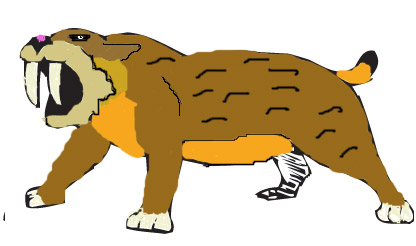Potential Fossil Treasure Trove in Venezuelan Tar Pit
South American Tar Pits may Yield Fossil Treasure Trove
Tar pits are wonderful places to find fossils. They form when natural asphalt seeps upwards from fissures in the overlying sediment above oil bearing rocks. This asphalt collects in pools on the surface and rainwater collects on top, forming a thin watery film over the sticky tar.
The water reflects the sky and helps conceal the dangerous tar just below the surface, when thirsty animals come to drink at these “pseudo waterholes” they become stuck fast and mired and if the tar pit does not engulf them straight away the poor, unfortunate animals will starve to death. Their cries will attract predators and scavengers on the look out for an easy meal and they too will become stuck in the heavy tar.
La Brea Tar Pits
Perhaps the most famous tar pit site in the world is at La Brea, in downtown Los Angeles, California. The word “Brea” is Spanish for tar. La Brea has trapped an extraordinary number of Late Pleistocene animals, a surprising number of the area’s victims are carnivores. Hundreds of Dire Wolves (Canis dirus) and many Sabre-tooth cats (Smilodon sp.) have been trapped and preserved along with numerous smaller predators such as foxes, coyotes, skunks, weasels and even badgers.
When cataloguing the huge number of fossils of meat-eaters it has been noticed by American scientists that many of the carnivores were very young, very old or suffering from injuries. Among the Sabre-tooth cats for example, a large proportion of the specimens recovered from La Brea show signs of back trouble, with vertebrae of the lower back often fused together. Whether this is an inherent weakness in the backs of these animals or the result of an injury sustained is unclear. Perhaps the easy pickings of the tar pits encouraged diseased, injured, elderly or the inexperienced members of an animal population to gather round La Brea.
Perhaps South America will soon have its equivalent of La Brea. Ancient tar pits have been discovered in Venezuela as the state oil company excavated an oil pipeline in the eastern state of Monagas. Researchers have claimed that this is the most significant fossil find for 60 years.
Late Pliocene Pits
The prehistoric tar pits have yet to be fully mapped and explored but it is believed that they cover approximately 3 acres in size and date from the Late Pliocene, a time shortly after the continents of North and South America became connected by a land bridge.
The palaeontologists studying the site hope that fossils preserved in the tar pits will give them a better understanding of the interaction between migrating large mammal populations as once isolated ecosystems in North and South America converged and mingled together.
If this new site yields a number of Sabre-tooth specimens this may help the scientists to learn more about the development of the Smilodon genus.
An Illustration of a Sabre-Toothed Cat

Picture credit: Everything Dinosaur
To see a model of a Sabre-Tooth Cat and other prehistoric animals: Prehistoric Animal Models.
Before the land bridge was formed, occasional falls in the Atlantic and Pacific ocean levels may have turned some present-day seabeds into land, allowing animals to migrate across chains of islands in the West Indies and what is now the countries of Panama and Costa Rica.

